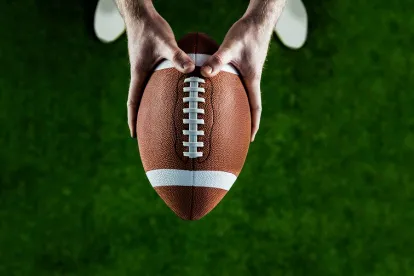On September 29, 2021, the National Labor Relations Board’s (NLRB) new General Counsel issued a memorandum that student-athletes at private colleges and universities should be considered employees under the National Labor Relations Act (NLRA).
The memo, if adopted by the NLRB, will have far-reaching consequences for private educational institutions including that students will have the right to unionize, have a representative negotiate their wages, hours and other terms and conditions of employment, be entitled to an array of costly benefits, including health insurance, vacation and other days off, and engage in strikes or other work stoppages sanctions under the NLRA.
The Goulston & Storrs College Sports Law Practice knows the issues. It can work with you to contest such a policy, minimize the adverse consequences of an NLRB determination that students are employees and minimize the risks for your school.
Labor Policy
The NLRA reflects the country’s commitment to unionization and collective bargaining as means to avoid labor strife and level the playing field for employees. It provides for employees of private employers to unionize, bargain collectively for the wages, hours and terms and conditions of employment and engage in work stoppages, including strikes, as a means to advance their collective goals.
One key to the NLRB’s jurisdiction is that there must be an “employee” over which the NLRB may assert jurisdiction. Under the NLRB’s rules, the NLRA applies to an employee “who perform[s] services for another and is subject to the other’s control or right to control.” Boston Medical Center, 330 NLRB at 160. To date, the NLRB has declined jurisdiction over student-athletes.
Background
In 2014, a group of Northwestern student-athletes (football players) who received grant-in-aid scholarships petitioned the NLRB for recognition as employees within the meaning of the NLRA and to direct an election in a unit of the grant-in-aid student-athletes. §2(a). In 2015, the NLRB, in reversing the decision of an administrative law judge, held that the NLRB would not assert jurisdiction over the case. It concluded that “asserting jurisdiction . . . would not serve to promote stability in labor relations.”
The General Counsel’s Memorandum
Despite the Northwestern NLRB conclusion, the current NLRB General Counsel has opined that the Northwestern decision supports the NLRB asserting jurisdiction over student-athletes. The General Counsel bases her conclusion principally on three factors: (1) student-athletes perform “a service for [the school] and the NCAA that generate[s] significant revenue and reputational value; (2) the student-athletes receive compensation; and (3) the school and NCAA control the student-athletes terms and conditions of employment through rules and regulations. General Counsel Memo 21-08 at 3.
The General Counsel found further support for her position in the U.S. Supreme Court’s recent decision in Alston v. NCAA, 141 S. Ct. 2141 (June 21, 2121), particularly in Justice Kavanaugh’s concurring opinion. In Alston, Division I student-athletes commenced an antitrust action against the NCAA and its member schools, alleging they engaged in price-fixing by limiting “other educational benefits” that the schools may grant student-athletes. The Supreme Court unanimously held there existed a relevant market for student-athletes labor in which the NCAA and its member schools exercised monopoly power. The Supreme Court found that the conduct was anti-competitive and there existed less restrictive alternatives.
In concurring, Justice Kavanaugh suggested that other NCAA rules limiting the student-athlete’s compensation would violate the antitrust laws. He questioned, “whether the NCAA and its member colleges can continue to justify not paying student-athletes a fair share” of the revenues they generate. At 2168. Justice Kavanaugh opined whether by engaging “in collective bargaining,” students and colleges could resolve compensation issues. Id.
The General Counsel also pointed to the NCAA’s recent announcement that it would not apply its compensation rules to limit a student-athletes’ ability to monetize her or his name, image and likeness (NIL). GC Memo 21-08 at 6. And, the General Counsel noted an increase in “collective action at unprecedented levels” at colleges and universities in the wake of George Floyd’s murder, the pandemic and other issues. GC Memo 21-08 at 7.
Based on those factors, the NLRB General Counsel concluded that “it is [her] position that the scholarship football players at issue in Northwestern University, and similarly situated Players at Academic Institutions, are employees under the [NLRA].” GC Memo 21-08 at 9. She further wrote that she “will be taking that position in further investigations and litigation under the Act,” and notified private colleges and universities that if they do not classify student-athletes as employees, the NLRB “will also consider pursuing a misclassification violation” of the NLRA.
Analysis
The NLRB General Counsel has decided to revive an issue that the NLRB held, just five years ago, did not further the NLRA’s goal – the promotion of labor stability. Principally relying on the administrative law judge’s findings and conclusions in the Northwestern University case, which the NLRB declined to adopt, the General Counsel has announced a potential new rule for which she will seek investigations and lawsuits to adopt.
In the Memorandum, the General Counsel adopted a number of questionable assumptions in an effort to justify her “opinion.” For example, the General Counsel concludes that the Northwestern University decision was incorrect because in the General Counsel’s view the facts compel a contrary conclusion. But the General Counsel offers no facts to show how a change in the decision would promote “stability in labor relations” or why the NLRB should reverse a decision reached only five years ago.
Pointing to the Alston decision, the General Counsel appears to conflate the Supreme Court’s unanimous decision finding an antitrust violation based on the NCAA prohibited the payment of “other educational benefits,” with Justice Kavanaugh's concurring decision, in which no other Justice joined, questioning all other NCAA compensation restrictions. Also, a careful reading of Alston does not, as the General Counsel opines, reject amateurism. Instead, the Court found there were less restrictive alternatives than the one pursued by the NCAA.1
Finally, to reach her opinion, the General Counsel concludes that recent events, such as George Floyd’s murder and the pandemic, support the need for collective action. However, it is not clear why these events support a special need for unionization of student-athletes or distinguish them as a unit as opposed, for example, to dealing with all students on campus who may have the same concerns. The General Counsel does not suggest that all students would be eligible to be considered as employees.2
The NLRB General Counsel’s Memorandum has not been considered, much less adopted, by the NLRB. Nonetheless, the Memorandum is a “call to arms” to private colleges and universities that it may very well face the prospect of student-athletes being designated as “employees” under the NLRA and being entitled to unionize and bargain collectively for the compensation, hours and other terms and conditions of their employment.
Private colleges and universities need to examine their practices and prepare for what appears to be the NLRB’s inevitable decision to challenge the schools’ failure to classifying student-athletes as employees under the NLRA. Sitting back is not an option. For example, taking no position might invite the NLRB to act without the benefit of opposing views, including holding colleges and universities in violation of the NLRA for failing to classify student-athletes as employees. This is a high-stakes situation. Think of the adverse possibilities for your school of finding student-athletes to be employees:
-
This would allow student-athletes to retain a bargaining representative to negotiate with the school;
-
This would allow student-athletes to negotiate collectively over their wages, hours and working conditions, which could include paying student-athletes more than the school can afford, agreeing to let student-athletes have “holidays” as vacation time which could impact playing schedules and paying them health and other benefits that are not budgeted;
-
This could impact your competitive advantages in recruiting students who otherwise might attend public colleges or universities, which are not subject to the same requirements.
1 See Sarah Eberspacher & Martin D. Edel, Supreme Court Sides with Student-Athletes in Alston v. NCAA, Expands Permissible Types of Compensation, The National Law Review (June 21, 2121), https://www.natlawreview.com/article/national-collegiate-athletic-association-v-alston, cited in the Memorandum at 5, footnote 18.
2 There are other statements made by the General Counsel which have a disputed factual basis.




 />i
/>i

